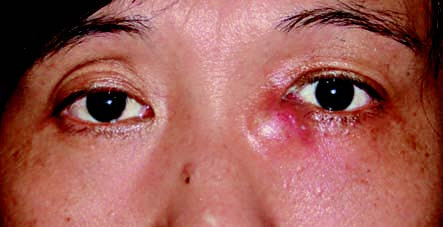Acute dacryocystitis most commonly occurs as a progression from chronic dacryocystitis and is associated with highly virulent bacterial invasion or reduced host immunity. The most common causative pathogens are Staphylococcus aureus or hemolytic streptococci. Acute dacryocystitis in neonates is rare, while pediatric cases are often linked to Haemophilus influenzae infection.
Clinical Manifestations
The affected eye presents with conjunctival hyperemia, tearing, and purulent discharge. The skin over the lacrimal sac region exhibits redness, swelling, and pain, with pronounced tenderness upon palpation. The inflammation may extend to the eyelid, nasal root, and cheek area, and in severe cases, it may lead to orbital cellulitis. Systemic symptoms such as chills, fever, and general discomfort may also appear. After several days, the redness and swelling may become localized, forming a pus-filled point. An abscess may rupture through the skin, allowing discharge of pus and resulting in a reduction of inflammation. However, in some cases, a lacrimal fistula may develop, leading to persistent leakage of tears through the fistula.

Figure 1 Photograph of a patient with acute dacryocystitis on the left side
Treatment
In the early stages, localized warm compresses and the use of systemic and topical antibiotics can help control inflammation. During the inflammatory phase, probing or irrigating the lacrimal duct system is contraindicated to avoid the risk of spreading infection and causing orbital cellulitis. If an abscess forms, incision and drainage may be performed. Endoscopic dacryocystorhinostomy may also be considered as a treatment option.